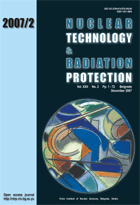
PATIENT DOSES AND IMAGE QUALITY IN CHEST RADIOGRAPHY: THE INFLUENCE OF DIFFERENT BEAM QUALITIES

Vol. XXII, No. 2, Pp. 1-72
December 2007
UDC 621.039+614.876:504.06
ISSN 1451-3994
Pages: 48 -52
Authors: Olivera CIRAJ BJELAC, Milan LONČAR, Dusko KOŠUTIĆ, Milojko KOVAČEVIĆ, Danijela ARANDJIĆ
Abstract
A simple method of assessing optimal X-ray beam quality in respect to patient exposure and image quality in chest screen-film radiography is presented here. Different beam qualities were generated by the use of various combinations of tube voltages (70 kV to 110 kV) and Al and Cu filter thicknesses. Patient doses were assessed by kerma-area product measurements. Simultaneously, image quality was evaluated by a twofold method: a clinical study applying European quality criteria for the radiographic technique of image on image of 126 patients and a multifunctional home-made dosimetric phantom with embedded test objects. The quantification of image quality criteria yields a simpler method of optimizing image quality and patient dose relationships. M odifications of radiographic practice, based on image quality assessment and dose measurements, resulted in significant dose reductions and preservation of image quality. Through the use of harder beam quality, dose reduction of up to a value of factor 3 were observed, compared to the doses from previously used radiographic techniques, implying that sufficient image quality does not necessarily imply higher doses. As a result of the optimization process, an optimal radiographic technique was suggested.
Key words: chest radiography, optimization, dose, image quality
FULL PAPER IN PDF FORMAT ( 235 KB)
Last updated on September, 2010